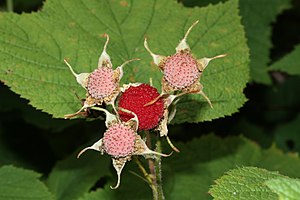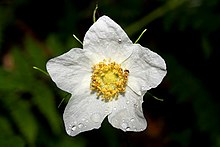Nutka raspberry
| Nutka raspberry | ||||||||||||
|---|---|---|---|---|---|---|---|---|---|---|---|---|

Nutka raspberry ( Rubus nutkanus ) |
||||||||||||
| Systematics | ||||||||||||
|
||||||||||||
| Scientific name | ||||||||||||
| Rubus nutkanus | ||||||||||||
| Moc. ex Ser. |
The Nutka raspberry ( Rubus nutkanus ) is a species of the Rubus genus within the rose family (Rosaceae). It is widespread in North America.
description
Vegetative characteristics
Rubus nutkanus is a dense, deciduous shrub and reaches heights of 0.5 to 2.0, rarely up to 3 meters. It often grows in large stands that spread through underground rhizomes . The upright branches are two years old and have a maximum diameter of 1.5 centimeters. The bark is initially sparsely hairy, later balding and has glands. Unlike many other types of Rubus , the Nutka White Raspberry has no spines .
The alternate leaves are arranged in a petiole and a leaf blade. With a length of 5 to 20 centimeters and a width of 5 to 25 centimeters, the simple leaf blade is much larger than most other Rubus species and is circular to kidney-shaped in outline with a heart-shaped blade base. The palmate, lobed leaf blade is slightly to moderately deep and rarely three or seven, mostly five-lobed. The leaf margin is roughly, irregularly serrated or double serrated. The spade tip is pointed or blunt. The underside of the leaf is bald to densely hairy and there are glandular hairs. The free each other, but fused with the petiole stipules are lanceolate with a length 5 to 15 millimeters to ovate.
Generative characteristics
The terminal and lateral, zymous to thyrsus-shaped inflorescences usually contain three to seven (1 to 15) flowers. The flower stalk is sparsely to moderately hairy and moderately to densely covered with yellowish to reddish glands.
With a diameter of 2 to 6 centimeters, the flowers of Rubus nutkanus are among the largest in the genus Rubus . The hermaphroditic flowers are radial symmetry and five-fold with a double flower envelope . There are five sepals . The five free, white petals are usually 14 to 22 (10 to 28) millimeters long and obovate. There are numerous pale yellow stamens . The stamens are thread-like. The many carpels are densely hairy in the upper area. The styles are club-shaped and glabrous.
The edible collective fruits are hemispherical with a diameter of 1 to 1.8 centimeters and ripen bright red in high to late summer. There are 50 to 60 stone fruits that are easily detached from the fruit base. As with other raspberries are not actual berries , but collecting drupes , which are arranged around a central fruit ground. The individual stone fruits can be carefully removed from the fruit base; they show their resemblance to a thimble, which is perhaps what gave the plant its name, because the literal translation of Thimbleberry would be “thimble berry”.
The number of chromosomes is 2n = 14.
Possible confusion
Rubus nutkanus can be confused with Rubus spectabilis (English also Salmonberry) or Rubus occidentalis (English also called Thimbleberry).
ecology
Pollinators of Rubus nutkanus are wild bees , honeybees and bumblebees . The leaves and flowers are caterpillars' nourishment and source of nectar for the hawkmoth Proserpinus flavofasciata . The fruits are attractive to birds.
Occurrence
Rubus nutkanus is distributed in western North America from Alaska and south to California , New Mexico and in the Mexican states of Chihuahua and San Luis Potosí . Its range extends eastward to the Rocky Mountains and discontinuously to the Great Lakes area . It thrives at altitudes from sea level in the north to 3000 meters in the south. There are localities for the Canadian provinces of Ontario , Alberta and British Columbia and the US states of Alaska, Oregon , Washington , Minnesota , South Dakota , Wisconsin , Michigan , Colorado , Idaho , Montana , Wyoming , Arizona , California, Nevada , Utah and New Mexico and the Mexican state of Chihuahua . Rubus nutkanus is a neophyte in many areas .
Rubus nutkanus typically grows on roadsides, railroad lines and clearings; it is usually a first colonizer in ecological succession on clearcuts and forest fire areas .
The Nutka raspberry is part of the understory in forests; typical companion species are the fern Dryopteris arguta , Trillium ovatum and Maianthemum racemosum .
Taxonomy
It was first described under the illegitimate name Rubus parviflorus in 1818 by Thomas Nuttall in The Genera of North American Plants. Philadelphia, USA. , Volume 1, pages 308-309. This name is invalid because the homonym Rubus parviflorus Tourn. ex Weston was published as early as 1770 in Botanicus universalis , 1, page 258. The valid name Rubus nutkanus was published in 1825 by Nicolas Charles Seringe in Augustin Pyramus de Candolle : Prodromus Systematis Naturalis Regni Vegetabilis , 2, page 566, where Seringe attributed the name to the botanist José Mariano Mociño . More synonyms for Rubus nutkanus Moc. ex Ser. are: Bossekia nutkana Greene , Bossekia parviflora (Nutt.) Greene , Rubacer parviflorum (Nutt.) Rydb. , Rubus natkanus G.Don , Rubus nutkanus var. Nuttallii Torr. & A.Gray , Rubus nutkanus var. Parviflorus (Nutt.) Focke , Rubus velutinus Hook. & Arn. , Rubus ribifolius C.K. Schneid. , Rubus parviflorus var. Bifarius Fernald , Rubus parviflorus var. Grandiflorus Farw. , Rubus parviflorus var. Heteradenius Fernald , Rubus parviflorus var. Hypomalacus Fernald , Rubus parviflorus subsp. velutinus (Hook. & Arn.) RLTaylor & MacBryde . Since the specific epithet parviflorus means "small-flowered" and Rubus nutkanus is one of the Rubus species with the largest flowers, the name has always been considered inappropriate. Now, in 2016, according to nomenclature rules, this naming problem became unimportant without being aimed at.
use
kitchen
The fruits are smaller, flatter and softer than raspberries and have many small seeds. Because of their soft consistency, they are poorly packaged and shipped, so they are rarely grown commercially.
Regardless of this, the wild Nutka raspberry can be eaten raw or dried. It is used to make jam, which is sold as a local delicacy in its area of distribution, namely on the Keweenaw Peninsula of the Upper Peninsula of Michigan. Cinnamon and raspberry jam is made from equal parts of fruit and sugar. The mass is boiled for two minutes and then poured into vessels. Without sugar, the cooked "berries" with their excellent sweet and sour taste can be kept in the refrigerator for some time and can be added to all kinds of desserts and vinaigrettes.
Cultivation
Rubus nutkanus is cultivated as an ornamental plant by specialized nurseries . It is also used in traditional natural gardens , in near-natural gardening and landscaping and in renaturation projects. The fruits are fragrant. The most successful propagation is by planting dormant rhizome parts or shoot sections or by seeds.
Cultivated forms
Cultivars were selected for their fragrant flowers and / or attractive autumn colors in various qualities.
A double-flowered form of the Nutka raspberry was discovered by Iva Angerman (1903-2008) between Squamish (British Columbia) and West Vancouver . This form has not appeared commercially, but is cultivated in the Botanical Garden of the University of British Columbia in Vancouver and the Royal British Columbia Museum in Victoria (British Columbia) .
Another double-flowered Nutka raspberry was found on Starrett Hill ( Monte Rio , California ) by Bob Hornback about 1975 ; it was known as the cultivar 'Dr. Stasek 'named after a Sonoma State University art professor .
medicine
Many parts of the Rubus nutkanus plant were used by Indians for a variety of medicinal purposes . Nutka raspberries have very high levels of vitamins A and C and can be used to treat scurvy. Wraps made from dried and powdered leaves can be used to treat wounds and burns, while the fresh leaves provide acne relief. A tea made from leaves or roots is given to treat nausea, vomiting, diarrhea, or dysentery . The leaves can also be used as natural toilet paper.
Common names in other languages
The common English name is Thimbleberry .
The Konkow , a Maidu tribe , call this species wä-sā ' ( Penuti languages ).
Individual evidence
- ↑ a b c d Rubus nutkanus in the Germplasm Resources Information Network (GRIN), USDA , ARS , National Genetic Resources Program. National Germplasm Resources Laboratory, Beltsville, Maryland. Retrieved September 3, 2019.
- ↑ a b c d e f g h i j k l m Lawrence A. Alice, Douglas H. Goldman, James A. Macklin, Gerry Moore: Flora of North America, Rubus parviflorus Nuttall - the same text online as the printed work , In: Flora of North America Editorial Committee (Ed.): Flora of North America North of Mexico. Volume 9: Magnoliophyta: Picramniaceae to Rosaceae. Oxford University Press, New York and Oxford, 2015, ISBN 978-0-19-534029-7 .
- ↑ a b Rubus parviflorus. In: Jepson eFlora . Jepson Flora Project - Jepson Herbarium; University of California, Berkeley, accessed January 18, 2017 .
- ^ David (Editor) Giblin: Rubus parviflorus . Burke Museum, University of Washington. 2015. Retrieved July 3, 2016.
- ↑ Earl JS Rook, Rubus parviflorus Thimbleberry photo
- ^ Rubus parviflorus at Tropicos.org. In: IPCN Chromosome Reports . Missouri Botanical Garden, St. Louis
- ^ A b c Lady Bird Johnson Wildflower Center, University of Texas: Rubus parviflorus . Retrieved February 12, 2013.
- ↑ Steven. K. Sullivan: Rubus parviflorus . 2015. Retrieved July 3, 2016.
- ^ Rubus parviflorus. In: PLANTS Database. United States Department of Agriculture = USDA - Natural Resources Conservation Service, 2015, accessed July 3, 2016 .
- ↑ SEINet, Southwestern Biodiversity, Arizona chapter with photos, description and distribution map .
- ↑ C. Michael Hogan. 2008. Coastal Woodfern (Dryopteris arguta) , GlobalTwitcher, ed. N. Stromberg ( Memento from July 11, 2011 in the Internet Archive )
- ^ Rubus parviflorus at Tropicos.org. Missouri Botanical Garden, St. Louis, Retrieved November 7, 2017.
- ↑ Abraham van de Beek: Validations of the Rubus taxa in Tournefort's Institutiones and their Corollarium in later literature. In: Adansonia , Series 3, Volume 38, June 24, 2016, pp. 35–53. PDF.
- ↑ Rubus nutkanus at Tropicos.org. Missouri Botanical Garden, St. Louis, accessed September 3, 2019.
- ↑ Günter Matzke-Hajek: Notes on the article by Abraham van deBeek "Validations of the Rubus taxa in Tournefort's Institutiones and their Corollarium in later literature" in Adansonia, sér. 3, 38: 35-53. 08/20/2016 - PDF.
- ^ A b Ethnobotany, University of Michigan
- ↑ Las Pilitas Nursery horticultural treatment: Rubus parviflorus - Thimbleberry .
- ↑ a b US Forest Service Fire Ecology
- ^ Anthony JF Griffiths, Fred R. Ganders: Wildflower Genetics-a Field Guide for British Columbia and the Pacific Northwest. . Flight Press, Vancouver 1983, ISBN 0-919843-00-X .
- ^ Native American Ethnobotany (University of Michigan - Dearborn) - for Rubus parviflorus . Retrieved November 17, 2017
- ↑ Henry Holly: Thimbleberry. In: The Northwest Forager ™. August 18, 2014, accessed January 18, 2017 .
- ^ Brian Klinkenberg (Ed.): Rubus parviflorus. In: E-Flora BC: Electronic Atlas of the Plants of British Columbia . Lab for Advanced Spatial Analysis, Department of Geography, University of British Columbia, Vancouver, accessed November 11, 2017 (in English, with photo and distribution in British Columbia).
- ^ Victor King Chesnut: Plants used by the Indians of Mendocino County, California . Government Printing Office , 1902, p. 408 (Retrieved August 24, 2012).




